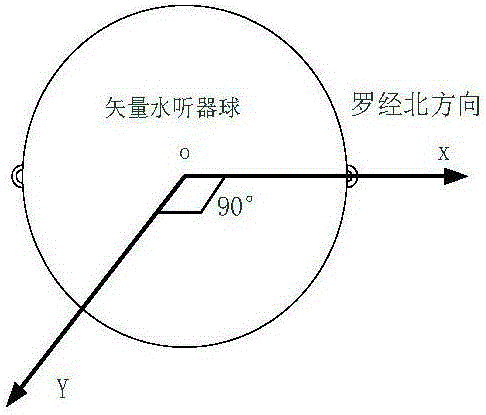Line spectrum signal object automatic detection method based on single-vector submerged buoy
An automatic detection, single vector technology, applied in the field of automatic detection of line spectrum signal targets, can solve the problems of difficult to achieve automatic detection of line spectrum targets, line spectrum instability and energy instability, etc. Occasional threshold false alarms and effects of eliminating influence
- Summary
- Abstract
- Description
- Claims
- Application Information
AI Technical Summary
Problems solved by technology
Method used
Image
Examples
specific Embodiment approach 1
[0029] The automatic detection method of the line spectrum signal target based on the single vector latent mark in this embodiment, the detection method is realized by the following steps: as figure 1 , figure 2 as shown,
[0030] Step 1, first-level detection:
[0031] The spectral data is used as input, and the number, frequency and orientation information of the threshold-crossing line spectra in the spectral data at the current moment are output through the first-level detection;
[0032] Step two, secondary detection:
[0033] Carry out time-based dynamic accumulation of the over-threshold line spectrum output after the first-level detection in step one, and count the number of cross-threshold times of the over-threshold line spectrum after each first-level detection, which is used for the following third-level detection, and the over-threshold line spectrum The frequency and azimuth information are cached in the tracking line spectrum buffer area for comparison with ...
specific Embodiment approach 2
[0038] The difference from Embodiment 1 is that in the method for automatic detection of line spectrum signal targets based on single-vector latent markers in this embodiment, the number, frequency and The process of orientation information is, for example, figure 2 The shown line spectrum automatically detects the first-level detection block diagram in the signal processing block diagrams at all levels,
[0039] Step 11, the sound pressure channel signal P is sequentially processed by the fast discrete Fourier transform operation method FFT and the average periodogram method to obtain a stable frequency spectrum curve;
[0040] Step one and two, take the logarithm of the stable spectrum curve, and then use the two-way α filtering method to obtain the continuous spectrum envelope;
[0041] Step 13: On the basis of the continuum envelope, remove the continuum interference background by adding a fixed value of the first-level detection threshold DT, obtain the line spectrum ou...
specific Embodiment approach 3
[0043] The difference from the second embodiment is that the process of obtaining the continuum envelope by using the two-way α filtering method described in step 12 is to use the two-way α filtering method to obtain the continuum envelope. The specific implementation process is as follows Figure 4 as shown,
[0044] First, set the measurement frequency band to f L ~ f H , f L and f H are the lower frequency limit and the upper frequency limit respectively;
[0045] Then, according to the calculation result of the power spectrum, the calculation formula of the two-way α filter of the two-way filter is adopted:
[0046]Y(k)=Y(k-1)+α[X(k)-X(k-1)] extracts the continuum trend; among them, X(k) represents the input sequence of the filter, and Y(k) represents the two-way The output sequence of the filter, k represents the current point in the sequence, and k-1 represents the previous point of the current point k. The input sequence in the present invention is a sound pressur...
PUM
 Login to View More
Login to View More Abstract
Description
Claims
Application Information
 Login to View More
Login to View More - R&D
- Intellectual Property
- Life Sciences
- Materials
- Tech Scout
- Unparalleled Data Quality
- Higher Quality Content
- 60% Fewer Hallucinations
Browse by: Latest US Patents, China's latest patents, Technical Efficacy Thesaurus, Application Domain, Technology Topic, Popular Technical Reports.
© 2025 PatSnap. All rights reserved.Legal|Privacy policy|Modern Slavery Act Transparency Statement|Sitemap|About US| Contact US: help@patsnap.com



